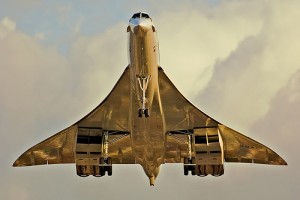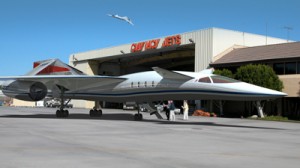
British Airways Concorde landing at Heathrow in 2003.
When the TU-144 and Concorde first went into service in the 1970’s , it was a time of aviation excitement. Both aircraft had the promise to completely revolutionize commercial transportation, providing speeds over twice the speed of sound (around 1100 mph vs 500-600 mph for other commercial airliners). Most thought the supersonic transport (SST) would replace other aircraft, to become the norm in general aviation. It was thought the sonic boom experienced when a jet goes over the sound barrier would become part of daily life, and people would be willing to live with them to have fast transportation.
The Tupolev TU-144 was the first SST to take flight in December 1968, two months before the Concorde. The TU-144 hit a big setback when the first production aircraft crashed during the 1973 Paris Air Show, killing all six crew members aboard and 15 people on the ground. Then in 1978 another TU-144 crashed during a pre-delivery test flight, killing all aboard. The aircraft type flew 55 passenger flights with Aeroflot before it was pulled from service in June of 1978, less than ten years after its first flight.
At the time Boeing was also working on their own SST, the Boeing 2707. The US didn’t want Europe and Russia to have the monopoly on SST technology, so the US government funded a contract for Boeing to study making its own. In 1963 the National Supersonic Transport program subsidized 75% of development costs to help Boeing directly compete with the TU-144 and Concorde. Since the Concorde and TU-144 were almost twins, Boeing wanted to make something different and were aiming to make a 250 passenger SST, which would hold about twice the passengers of the other two. In March 1971, funding for the project was canned by Congress and although private funding was able to raise nearly $1 million, the entire project was shut down in May of 1971. At the time, the Boeing 2707 had 115 orders from 25 airlines and the Concorde only had 74 order from 16 customers.
The Concorde and Tu-144 might have looked similar, but Arospatiale-BAC’s Concorde was superior in its avionics and capabilities. It has its first flight in March of 1969 and entered service in 1976. During that time, the first two prototypes traveled the world to build excitement and there were 70 orders for the plane. However, many orders were canceled after an oil crisis caused financial difficulty for the airlines, the crash of the similar TU-144, and concerns about the sonic-boom not being acceptable in populated areas. In the end, only British Airways and Air France took delivery of the Concorde. The plane was flown until 2003 when Air France flight 4590 crashed in France killing all 109 people aboard and raising questions about the safety of the aircraft. The aircraft was retired on November 26, 2003.

Supersonic Aerospace International's QSST rendering.
There was hope in the early 90’s for a resurgence of SST when a wealthy businesswoman, Judith DePaul, worked with Tupolev and NASA to use a TU-144 as a testbed for additional SST research. Over $350 million was spent on retrofitting the mothballed Tu-144 and it made a total of 27 flights through the 90’s, but was canceled in 1999 for “lack of funding.” Today, the aircraft is rusting away in storage with little hope of being used again.
It has been over 40 years since the first SST flight occurred and almost 6 years since the last SST commercial flight. It has seemed unlikely there will be a revival of the Concorde or TU-144, but there might be hope on the horizon. The biggest hurdle has been the sonic-boom heard when an aircraft passes the sound barrier. The loud and disruptive boom caused previous SST’s to be flown only over water. Scientists are currently working on ways to “shape” the boom, making it sound more like distant thunder, something that the general public could live with to allow flights over land.
Even if the technology becomes available, it is not going to be cheap. A round trip ticket from New York to London on the Concorde before its cancellation ran about $10,000.00 USD. However, history has shown new technology can be expensive at first but as it develops can become more cost effective. The Concorde didn’t have time to become less costly since the technology became stagnant.
It would be a long while before Boeing or Airbus would start seriously considering making a SST line of aircraft. But smaller business jet companies are spending good sums of money researching new technology that is being dubbed Quiet Supersonic Transport (QSST). Supersonic Aerospace International is working on creating the next generation of SST starting in the business jet realm. They are hoping to have their first aircraft flying by 2014 with first customer delivery in 2016. Even if they wouldn’t be able to make those optimistic goals, it seems like there would be a big market for business people being able to save time while in-flight around the world.
Who knows where the future will go for SST? Will the start of space travel help in the development in the next SST? I would think there might be some overlap. There are those that already talk about post-SST and moving to hypersonic flight , but that is going to be far out in the future. It seems it might be most beneficial for the technology to start on a smaller scale. It looks like smaller companies might create SST business jets and allow the wealthy to help pay for the development of the technology. As the technology grows, becomes more accepted and less costly, larger aircraft manufacturers could pick up the production of SST aircraft and usage would spread.
Images:Concorde (Spencer Wilmot)
QSST (SAI)